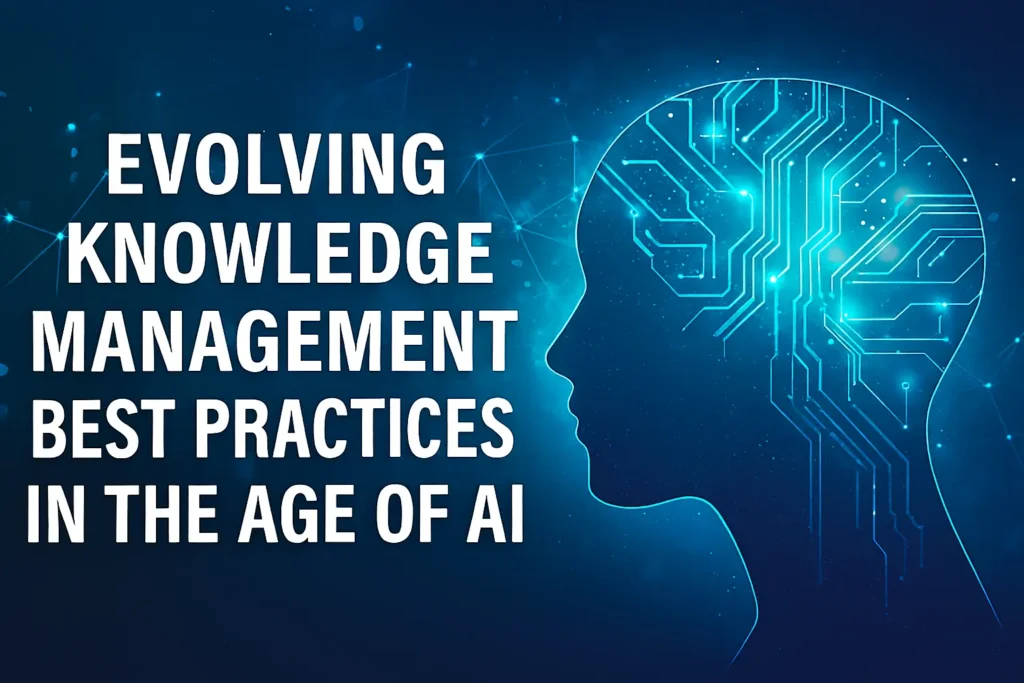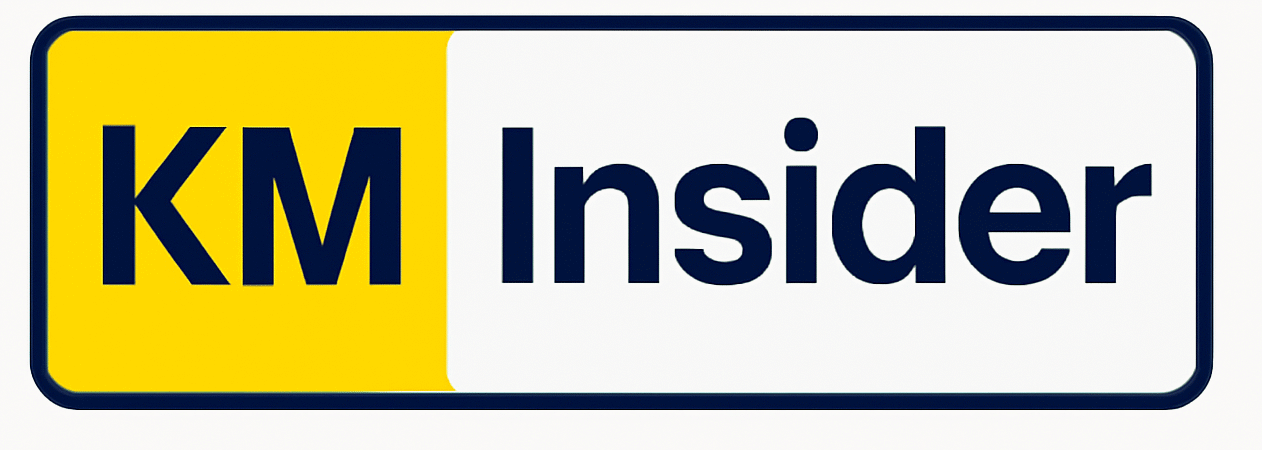The way organizations manage knowledge has always been a reflection of how they think, learn, and adapt. But in the age of artificial intelligence (AI), that reflection is sharper and faster than ever before. Traditional knowledge management best practices—built on document repositories, taxonomies, and collaboration tools—are being redefined by automation, intelligent search, and machine-driven insights.
This shift isn’t just about upgrading tools. It’s about transforming how knowledge flows through an organization, how it’s discovered, and how it fuels decision-making.

Understanding Knowledge Management in the AI Context
At its core, knowledge management (KM) remains the same: capturing, organizing, and sharing knowledge so people can make better decisions.
What’s changing is how it’s done.
AI is introducing a new layer of intelligence to KM by:
- Automating content categorization and tagging, reducing manual effort.
- Enhancing search through semantic and contextual understanding.
- Delivering personalized knowledge to employees when and where they need it.
- Predicting knowledge gaps by analyzing usage and engagement patterns.
These developments are redefining what we mean by best practices. They require new thinking—balancing human expertise with machine intelligence.
Read: Knowledge Management Best Practices and Effective Strategies for Success
The Evolution of Knowledge Management Best Practices
Let’s look at how traditional KM best practices are evolving in the AI era.
1. From Collecting Information to Curating Insights
Old KM systems focused on storing documents and data. Modern systems powered by AI focus on curation. They identify relevant, accurate, and timely information, surfacing what truly matters.
New best practice:
Adopt an AI-supported knowledge lifecycle—where collection, validation, and retirement of knowledge are continuously optimized.
2. From Manual Tagging to Smart Classification
Earlier, KM professionals relied heavily on taxonomies and manual tagging. Today, AI models can understand context, sentiment, and relationships between topics.
New best practice:
Use AI-driven metadata generation to classify content dynamically. Combine this with human review to maintain accuracy and trust.
3. From Searching to Discovering
Search used to be about finding what you already knew existed. Now, AI-driven discovery suggests related insights you didn’t even think to ask for.
New best practice:
Implement semantic search and generative Q&A tools within your KM system to deliver context-aware results, improving discoverability and user satisfaction.
4. From Knowledge Silos to Integrated Intelligence
Enterprises have long struggled with silos—knowledge locked in different departments or systems. AI can now integrate data across applications, emails, chats, and documents to build unified knowledge graphs.
New best practice:
Adopt knowledge graph technology to map relationships across information assets and make cross-departmental knowledge easier to access.
5. From Static Repositories to Continuous Learning Systems
A knowledge base used to be static—a collection of “final” documents. AI now keeps content alive, continuously updating it with new insights, metrics, and real-time data.
New best practice:
Create dynamic, self-updating knowledge bases where content evolves automatically, supported by AI monitoring and human review cycles.
Human-Centric Best Practices That Still Matter
Even as AI transforms KM, human judgment remains irreplaceable. The best systems blend automation with human wisdom. Here are enduring knowledge management best practices that continue to define effective KM programs.
1. Define Clear Ownership and Governance
No AI system can replace the importance of knowledge ownership. Assign responsibility for maintaining accuracy, archiving outdated content, and ensuring compliance.
2. Foster a Knowledge-Sharing Culture
Technology only amplifies the culture that already exists. Encourage open communication, reward knowledge contributions, and make learning part of performance goals.
3. Measure What Matters
Metrics such as reuse rate, time saved, or reduced onboarding time tell the real story of KM’s impact. AI can help track these metrics automatically—but leadership must interpret and act on them.
4. Blend Explicit and Tacit Knowledge
AI handles explicit knowledge well—documents, FAQs, process maps. But tacit knowledge (insights, experiences, intuition) still requires human interaction. Combine digital knowledge bases with communities of practice or mentoring programs to keep both streams flowing.
5. Prioritize Accessibility and Inclusion
AI can improve accessibility through voice search, multilingual translation, and contextual recommendations. But ensure your KM design remains inclusive—usable for employees with different skills, languages, and devices.
Integrating AI into Your Knowledge Management Strategy
If you’re modernizing your KM program, start small and scale gradually. Here’s a practical approach that organizations worldwide are following:
- Audit existing knowledge assets – Identify what’s valuable, outdated, or underused.
- Introduce AI-enabled search – Improve findability before overhauling the whole system.
- Leverage chatbots or virtual assistants – Let employees access answers naturally through conversation.
- Automate tagging and content analysis – Reduce the burden on content authors.
- Use predictive analytics – Detect emerging topics or knowledge gaps early.
- Implement feedback loops – Combine AI-generated insights with human validation.
Each step strengthens your foundation while preparing your organization for a fully intelligent KM ecosystem.
Common Pitfalls to Avoid in AI-Driven Knowledge Management
As powerful as AI can be, its misuse can create new problems. Here are pitfalls to watch for:
- Over-automating without context – Blindly trusting AI tags or summaries can lead to misinformation.
- Neglecting human validation – Always keep an expert review layer for quality control.
- Ignoring data ethics and privacy – Ensure transparency about how knowledge is collected and used.
- Lack of change management – Employees must understand why the system is changing and how it benefits them.
- Failing to align with business outcomes – AI in KM should drive measurable improvements—faster decisions, better customer support, or reduced duplication of effort.
| Aspect | Traditional KM | AI-Driven KM |
|---|---|---|
| Knowledge Capture | Manual entry and categorization | Automated extraction and tagging |
| Search Experience | Keyword-based | Contextual and semantic |
| Maintenance | Periodic updates | Continuous learning and self-correction |
| User Experience | Passive, requires searching | Proactive, recommends relevant knowledge |
| Scalability | Limited by human effort | Expands automatically with data growth |
| Decision Support | Descriptive (what happened) | Predictive (what might happen next) |
The Future of Knowledge Management Best Practices
As AI capabilities expand, KM will evolve toward proactive intelligence—systems that not only answer questions but anticipate them.
The next generation of KM will:
- Learn from user behavior to personalize knowledge delivery.
- Generate real-time insights across systems.
- Integrate with digital workplaces to support hybrid and remote teams.
- Enable multilingual, voice-driven, and visual search experiences.
The organizations that thrive will be those that maintain the right balance: trusting AI to scale knowledge, but keeping humans in charge of meaning.
Final Thoughts
The essence of knowledge management best practices has always been about connecting people with the right information at the right time. AI doesn’t replace that goal—it enhances it.
When used wisely, AI transforms knowledge management from a static archive into a living system that learns, adapts, and evolves alongside the organization. But it’s the combination of technology, trust, and culture that defines long-term success.
In this new age of AI, the best knowledge management practices are not about doing more—it’s about doing it smarter, faster, and with greater purpose.
